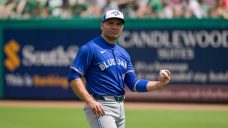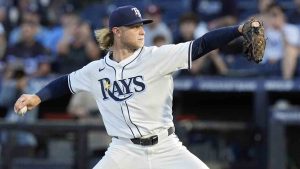DUNEDIN, Fla. — He couldn’t even begin to tell you why, but for as long as Ernie Clement can remember, he’s been able to get his bat to everything.
From hacking away in little league coach-pitch, through setting a Brighton High School record by hitting .560 in a season, to winning a College World Series with the University of Virginia, being named MVP of the prospect-laden Cape Cod League, getting drafted by Cleveland, hitting over .300 at the Arizona Fall League, breaking through to the majors and finding his way to the Toronto Blue Jays — a team he’s well positioned to open the 2024 season with in a utility role — Clement has yet to encounter a level of pitching he can’t make contact with.
Over 836 college plate appearances, Clement struck out 31 times. Of his 1,660 minor-league plate appearances, only 130 have ended in a strikeout. In the majors, where pitchers are nastier than anywhere on the planet, Clement’s 13.5 per cent strikeout rate and 86.3 per cent contact rate since 2021 each rank within the league’s 95th percentile.
"Hitting the ball has never really been a problem,” he confirms. “But hitting the ball hard and at the right angles has been a struggle.”
That’s why Clement couldn’t hang around in the majors when he earned opportunities with Cleveland and the Oakland Athletics in 2021 and 2022. And it’s what the Blue Jays believed they could help him get better at when he was released by Oakland a year ago.
Toronto wasn’t the only team that felt that way — Clement had options as a free agent last spring. But the Blue Jays were able to promise him regular triple-A playing time and sell the 27-year-old on their plan to help him get more out of his uncanny contact ability.
That started with addressing tendencies in Clement’s swing path that led to elevated groundball rates. After getting to know Clement for a couple weeks and learning how he liked to be coached, Matt Hague — then the Buffalo Bisons hitting coach, now a member of Toronto’s big-league staff — began drilling him with a variety of tee work during long sessions in Buffalo’s batting cages.
Hague placed balls at varying heights and asked Clement to focus on hitting them in different directions. From there, they progressed to doing the same with balls Hague flipped to him from close range, and eventually pitches from a high-velocity machine. The idea was to slowly instill muscle memory that would allow Clement to naturally have more depth in his swing without needing to think about it.
“It wasn’t like he was telling me, ‘Hey, you need to do this.’ It was more, ‘Hey, let’s work on this. Let’s see how this feels,’” Clement says. “That’s how I like to work. I told him, ‘Dude, mechanically, I don’t know what’s going on. But I know I want to think about it as little as possible.’ And he was like, ‘All right, I got you.’
“And from there, over time, the drills that he gave me just allowed for it to happen naturally. We just kept building with little things. Before, I had a really short swing; I had a direct-to-the-ball approach. But as we worked on it, I just naturally got a little more depth. I started getting through the ball a lot better.”
The results speak for themselves. After posting triple-A groundball rates above 40 per cent each of the prior two seasons, Clement shaved several points off that mark in 2023, funnelling them and then some into his line drive rate:
Ernie Clement triple-A contact
That helped Clement hit .348/.401/544 across 320 triple-A plate appearances last season and obliterate his previous career-high in homers — he topped out at four in 2022 — with 11. He still made exceptional contact with pitches all over, running triple-A’s lowest strikeout rate at five per cent. But the shape of that contact improved dramatically, which is how he ended up with the International League’s 10th-highest wRC+ at 136.
And in his limited big-league opportunity last year, Clement made line-drive contact nearly a quarter of the time he put a ball in play. He reached base in 20 of his 52 plate appearances and hit the hardest, longest home run of his career — a 404-foot shot that came off his bat at over 105 mph. So far this spring, he’s kept that groundball rate below 35 per cent and has 13 hits in 37 trips to the plate, including homers off Corbin Burnes and Zach Eflin.
“I’ve really just picked up where I left off last year,” he says. “I'm just continuing to build off of it and get better at what I do well. Now that I have more depth, I have more room for error. If I'm late, I'm still able to hit a line drive the other way. If I'm early, I'm able to hit a line drive to the pull side. My approach is always in the middle of the field. But if I'm early or late, I'm still able to drive the ball.”
The next step for Clement is using his refined mechanics to execute a more intentional plan against opposing pitchers. Clement swung at 44.2 per cent of the pitches he was thrown outside the strike zone last season, which ranked 15th in MLB among the 542 players to make at least 50 plate appearances. It’s the accompanying curse of Clement’s gift for contact — he can go after pitches many hitters wouldn’t dare to and put them in play.
But when you’re trying to drive the ball more consistently, swinging at stuff off the plate isn’t a great way to do it. So, Clement’s discussions with Hague and other Blue Jays hitting coaches this spring have centred around understanding the pitches he does his best damage against, formulating a plan for each pitcher he faces, hunting a particular pitch in a specific area of the zone, and fighting his innate urge to swing away at whatever he sees.
“In the past, I've got myself out a lot on pitcher's pitches,” Clement says. “Now, I’m trying to be more selective, take those pitches, and find something a little bit better. I feel like I've really grown and matured in my approach.”
Of course, there’s a balance here. The Blue Jays don’t want to take away what makes Clement special. And when he’s in two-strike counts, Clement has licence to battle, using his contact ability to put balls in play and his 76th percentile sprint speed to put pressure on defences. For as much as Clement’s approach has changed, some things will always remain the same.
“Striking out is just the worst feeling. I don't ever want to strike out. I'd rather put one in play and at least give myself a chance to get on,” he says. “So, it's just a mindset to me. Early in counts, I’m not swinging just to swing. I’m swinging with intent within my plan and trying to drive the ball. With two strikes, I'm up there competing. I'm battling my tail off.
“Sometimes I wish I could work my walks like [Davis] Schneider and [Spencer] Horwitz. But it is what it is. I know what I do well. So, I've just got to hone in on that.”







